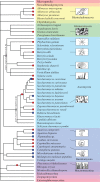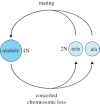Polyploidy in fungi: evolution after whole-genome duplication
- PMID: 22492065
- PMCID: PMC3350714
- DOI: 10.1098/rspb.2012.0434
Polyploidy in fungi: evolution after whole-genome duplication
Abstract
Polyploidy is a major evolutionary process in eukaryotes-particularly in plants and, to a less extent, in animals, wherein several past and recent whole-genome duplication events have been described. Surprisingly, the incidence of polyploidy in other eukaryote kingdoms, particularly within fungi, remained largely disregarded by the scientific community working on the evolutionary consequences of polyploidy. Recent studies have significantly increased our knowledge of the occurrence and evolutionary significance of fungal polyploidy. The ecological, structural and functional consequences of polyploidy in fungi are reviewed here and compared with the knowledge acquired with conventional plant and animal models. In particular, the genus Saccharomyces emerges as a relevant model for polyploid studies, in addition to plant and animal models.
Figures





References
-
- Wendel J. F. 2000. Genome evolution in polyploids. Plant Mol. Biol. 42, 225–24910.1023/A:1006392424384 (doi:10.1023/A:1006392424384) - DOI - DOI - PubMed
-
- Otto S. P., Whitton J. 2000. Polyploid incidence and evolution. Annu. Rev. Genet. 34, 401–43710.1146/annurev.genet.34.1.401 (doi:10.1146/annurev.genet.34.1.401) - DOI - DOI - PubMed
-
- U, N 1935. Genome analysis in Brassica with special reference to the experimental formation of B. napus and peculiar mode of fertilization. Jpn. J. Bot. 7, 389–452
-
- Blanc G., Wolfe K. H. 2004. Widespread paleopolyploidy in model plant species inferred from age distributions of duplicate genes. Plant Cell. 16, 1667–167810.1105/tpc.021345 (doi:10.1105/tpc.021345) - DOI - DOI - PMC - PubMed
-
- Ohno S. 1970. Evolution by gene duplication. Berlin, Germany: Springer
Publication types
MeSH terms
LinkOut - more resources
Full Text Sources
Other Literature Sources
Medical
Molecular Biology Databases
Miscellaneous

